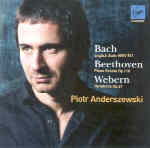Virgin Classics’ 2004 copyright date and latter-day jacket photo of Piotr Anderszewski are deceiving. It’s only when you break the shrink-wrap and read the booklet notes that you discover that this is not a new release but in fact is the pianist’s 1996 solo-debut CD. It first appeared on the Accord label, when Anderszewski was less famous than he is today. Like Michelangeli, Zimerman, and Pogorelich, Anderszewski commands high levels of personal force and technical refinement, rarely making a move without thinking twice. For pianistic architecture alone, it’s easy to admire the unruffled beauty and carefully calibrated dynamic plateaus he lavishes upon Bach’s D minor English Suite. His trills and mordents are fastidious yet understated, while melodic embellishments in the repeats catch you off guard–and couldn’t be more stylistically apt.
But sometimes Anderszewski’s playing is too studied for its own good. In Gavotte No. 1, for instance, he achieves remarkable distinction between his detaché, woodwind-like articulation of the right-hand melodic material and his velvet-coated legato rendering of the busy left-hand counterpoint. But these components seem to occupy their own bubbles rather than mingle and converse. And the Sarabande’s inner pulse nearly evaporates at the pianist’s dangerously slow tempo. By contrast, both Murray Perahia and András Schiff are more attuned to the music’s harmonic tension and dance-oriented core.
Deliberation also prevails in the outer movements of Beethoven’s Op. 110, in contrast to the little second movement that truly takes the composer’s Allegro molto marking at face value, and then some. In the latter, Anderszewski overstates Beethoven’s vehement dynamic contrasts in a manner more appropriate to Prokofiev. He blends the Fugue’s polyphony with a keen ear for color and nuance, but without the linear definition and forward-moving exultation that make Richard Goode’s recording all the more satisfying.
On the other hand, the sparsely scored Webern Variations rarely have sounded so vibrant and texturally varied, as if three or four different pianos were being deployed. Anderszewski carefully dissects each pitch, each dynamic, each accent, and each phrase, and puts everything back together in one compelling piece. Even the equally scrupulous Pollini recording sounds relatively monochrome by comparison, although Peter Serkin’s warmer understatement puts a more lyrical spin on the two outer sections. However you respond to Anderszewski’s interpretations, it’s clear that the direct line from Anderszewski’s brain down to his fingers already was up and running in 1996.
































